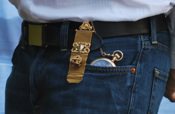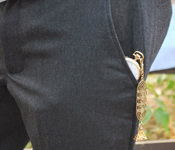Ribbon-style, or "fob" style chains, are the oldest of the pocket watch chain styles, predating straight and Albert chains and used even before vest pockets, as small pockets in pants were common thru the 1800s. Ribbon-style chains can be for men or women, and can be attached to clothing, by a spring ring or belt clip for example, or remain unattached, as they were when they were first introduced. The ribbon section of the chain may be made from a variety of materials; on this page are featured three of the most common: fabric, metallic mesh, and metallic panels.
Note: although the watches in the following photos are shown half-out-of-pocket, this is merely to illustrate the attachment of the chain to the watch. Pocket watches should be worn entirely inside the pocket, ideally within a velvet or thin leather pouch for protection.
[click on any of the below photos for an enlarged view]
Among the main ribbon-style chain materials, fabric is the most rare. Although used as pocket watch accessories historically, few examples of original fabric ribbons remain today. While the fabric ribbon chains were very prolific when they were in fashion, the delicate nature of the material has since prevented many chains of this style from remaining functional. Today, you will see many more styles created from metallic mesh or metal panels, as noted below. The following photos demonstrate three different ways to wear a ribbon chain that is intended to attach to the wearer's garment.
Mesh ribbons were often employed to display medals or badges from military service, fraternal organizations, or clubs. The photos here show an example of a clip which could be attached to a belt, waistband, hem, or pocket. In this instance, the pocket watch is attached to the ribbon's clip by a short length of link chain.
The panel style of ribbon chains is characterized by a series of segments that are hinged together, producing a flexible but sturdy ribbon chain to which a pocket watch can be attached. The majority of these panel-style chains are made of some type of metal, although other materials are occasionally seen as well.
Among the various types of ribbon watch chains, the panel style has become the most popular women's option (see fourth photo below), as they are available in smaller dimensions and often are not designed to attach to any specific articles of clothing.

Regardless of the method used to attach the chain to the wearer's vest, shirt, or pants, the bow of the pocket watch is attached to the chain with a small swivel clasp that allows the watch to rotate and keeps the chain from twisting. These swivels are findings that are traditionally used with pocket watches on most vintage pocket watch chains. As opposed to many of the more modern styles, these do not have any small latches to pull back but rather part of the oval "clip" section depresses into the finding, allowing you to slip in your pocket watch bow or fob lanyard. Once released, it has a small internal spring that closes the oval loop back up and prevents whatever is clipped from accidentally coming out without your intervention.
A pocket watch can be worn on either side of the body depending on the preference of the wearer. For instance, many right-handed wearers may have their pocket watch on the left side of the body; this allows for winding with the right hand while holding the watch with the left. However, a right-handed wearer may instead choose to keep the watch on the right for ease-of-use when pulling and returning the watch to a pocket as well.
We are also in the process of collecting photos of pocket watch chain fashion and ideas, which can be easily viewed on the following Pinterest Board. Please let us know if you have any photos to contribute!
Related Products:
Vintage Mens Pocket WatchesVintage Ladies Pocket Watches
Ribbon-Style Pocket Watch Chains
Jewelry & Watch Polishing Cloths
More "How To Wear" watch chain pages:
Straight Watch ChainsAlbert Watch Chains
Double Albert Watch Chains
Other Styles Of Watch Chains
More Ladies' Styles For Watch Chains
➔ Return to the main "How To Wear" page
➔ View a PDF version of this page for easy printing or downloading

 Fabric Ribbon Chain (Vest, Hanging)
Fabric Ribbon Chain (Vest, Hanging)
 Fabric Ribbon Chain (Vest, Pocketed)
Fabric Ribbon Chain (Vest, Pocketed)
 Fabric Ribbon Chain (Slacks)
Fabric Ribbon Chain (Slacks)
 Mesh Ribbon Chain
Mesh Ribbon Chain
 Detail of Belt Clip
Detail of Belt Clip
 Panel Ribbon Chain (Vest)
Panel Ribbon Chain (Vest)
 Panel Ribbon Chain (Slacks)
Panel Ribbon Chain (Slacks)
 Panel Ribbon Chain (Men's Jeans)
Panel Ribbon Chain (Men's Jeans)
 Panel Ribbon Chain (Women's Jeans)
Panel Ribbon Chain (Women's Jeans)